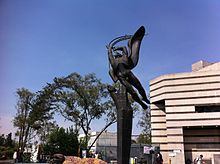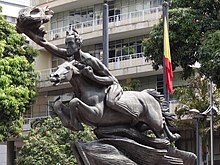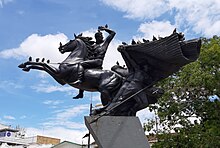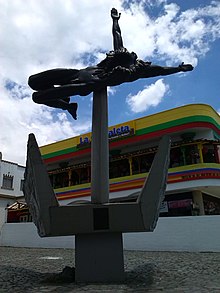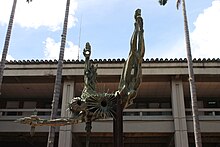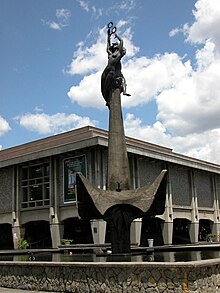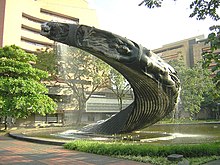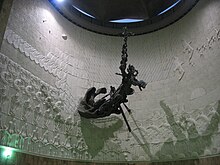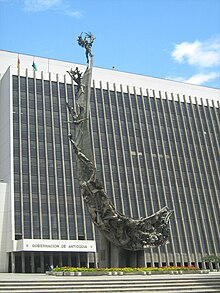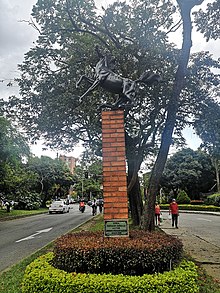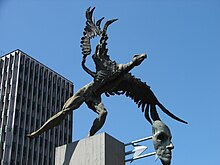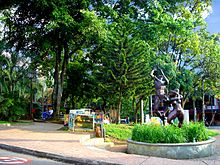Rodrigo Arenas Betancourt
Rodrigo Arenas Betancourt (El Uvital, rural area of Fredonia (Antioquia), October 23, 1919 - Medellín, May 14, 1995) was a Colombian sculptor and writer.
He is considered one of the most prolific and nationally and internationally appreciated Colombian artists. His works are characterized by being gigantic, melodramatic and spectacular, highlighting in many of them the great characters of Colombian history as well as his important deeds and works. Many of his sculptures are public monuments, with almost all of his work being found in different cities in Colombia and Mexico. Some works that were not conceived to be exhibited in public remain in Caldas (Antioquia) under the care of his wife, María Elena Quintero de Arenas, and his five children. He was a serial sculptor who always worked with bronze, concrete, and steel, although some of his early work also included terracotta. He won the Colombian National Plastic Arts Award in 1975, awarded by Colcultura.
Biography
He was the son of a peasant couple from Antioquia. In his childhood he dedicated himself to helping his parents with agricultural work in Fredonia, his hometown. After finishing his basic primary studies, he had a fleeting experience as a seminarian between 1931 and 1932 at the Yarumal Mission Seminary. Around 1938 he began to develop his facet as a sculptor carving Christs in wood and also as an assistant in the construction of works for different sculptors and muralists, such as Pedro Nel Gómez and Bernardo Vieco. He studied at the Institute of Fine Arts of Medellín and at the School of Fine Arts of the National University of Colombia (Bogotá), between 1939 and 1941. In 1944 he decided to settle in Mexico to develop studies at the Academy of San Carlos and in the Free Association of Art La Esmeralda. During his stay in this country, he alternated his studies in plastic arts with work related to his artistic facet. He was an assistant set designer at Estudios Azteca, a writer and columnist in print media, a sculptor, and an art photographer. He was an art professor at the Ciudadela de México School of Crafts, of which he was also one of its founders.
Between 1959 and 1966 he worked in the United States and from there he went to Europe, where he lived until the end of 1966. During his stay in the old continent, Arenas Betancourt also served as Minister Counselor of the Colombian Embassy in Italy. Returning to Colombia definitively, at the beginning of 1967, he established his art workshop in the municipality of Caldas (Antioquia), where he had beginner collaborators and some experienced ones. In his country, he also served as an artistic advisor to the University of Antioquia.
During his professional career he worked on different materials. There are from drawings, portraits and watercolors to giant works that mix steel and concrete. He was also a skilled sculptor who used plaster, wood, basalt, stone, bronze, and terracotta, among others. From the beginning of the 1950s he began to carry out his largest works, generally commissioned by government entities, private companies and some simply developed by his personal taste.
Cuauhtémoc, one of his great sculptures created between 1953 and 1954, 18 meters high and made of bronze and basalt, which was expressly commissioned by the Mexican government to be installed in The Building of the Secretariat of Communications and Public Works (SCOP) in Mexico City, was irreparably damaged in the 1985 Mexico earthquake.
On October 18, 1987, he was kidnapped by the FARC in Caldas (Antioquia), when he was traveling with his wife and children. He was released on January 1, 1988 after 81 days in captivity, after his family paid a large sum of money that his kidnappers demanded. During this period he dedicated himself to making drawings in a notebook and writing about his experiences in captivity, which later became the basis for the creation and publication of his book The steps of the condemned .
He died at the El Rosario Clinic in Medellín in 1995 due to liver cancer. His remains rest in Fredonia.
Outstanding works
Among his most outstanding works and currently on public display are the following:
| Work | Image | Date of construction | Height | Country | Location |
|---|---|---|---|---|---|
| Prometheus (and Quetzalcoátl) | 1951 - 1952 | 7.7 m | Mexico | Faculty of Exact Sciences of the National Autonomous University of Mexico (UNAM), Mexico City | |
| Prayer to the Proscribe | 1957 | 3.6 m | Colombia | ElDorado International Airport, Bogotá | |
| Prometheus Chain | 1957 | 2.5 m | Colombia | Alternate Headquarters Museum of Antioquia, Medellín (Antioquia) | |
| La Guacamaya Herida | 1959 | 2.5 m | Mexico | Work specifically. Fruit Lomas de Cuernavaca, Cuernavaca (Morelos) | |
| Monumental heads of the heroes of the Mexican Revolution: Moreno, Hidalgo, Juárez and Zapata | 1959 - 1960 | 2.5 m each | Mexico | Located in different places | |
| Bolívar Desnudo | 1956 - 1962
Inaugurated in 1963 | 10 m | Colombia | Bolivar Square, Pereira (Risaralda) | |
| Tribute to General José María Córdova | 1957 - 1964 | 6 m | Colombia | Main Park, Rionegro (Antioquia) | |
| Prometheus
(Monument to the Founders) | 1965 | 10 m | Colombia | Carrera 13 con Calle 13, Avenida Circunvalar, Pereira (Risaralda) | |
| Long Journey of the Vien to the Heart of Fire | 1964 - 1966 | Two panels of 3 x 8.5 m each | Colombia | Facade of building of the Beneficent of Antioquia, Av. Sucre with Ayacucho, Medellín (Antioquia) | |
| Christ Falling
(Cristo Prometheus) | 1965 - 1968 | 6 m | Colombia | Central Patio del Bloque 16 de la Universidad de Antioquia, Medellín (Antioquia) | |
| Prometheus Chain | 1967 - 1968 | Colombia | Main Term of the Technological University of Pereira, Pereira (Risaralda) | ||
| The Flautist and the Dog | 1969 | 1.6 m | Colombia | San Ignacio Building, University of Antioquia, Medellín (Antioquia) | |
| The Creator Man of Energy
(Promethes) | 1968 - 1970 | 18 m | Colombia | Central Plate of the University of Antioquia, Medellín (Antioquia) | |
| Lanceros del Pantano de Vargas | 1968 - 1971 | 33 m | Colombia | Paipa (Boyacá). It is the largest monument and/or sculpture in Colombia. It was declared a National Monument through Decree 1744 of 1 September 1975. | |
| The Life
(Infinite Man's Temptation) | 1971 - 1974 | 14 m | Colombia | Plazoleta Edificio Suramericana de Seguros, Medellín (Antioquia) | |
| Monument in tribute to the Cacica Gaitana | 1974 | 21 m | Colombia | Av. Circumvalate with Calle 4, Neiva (Huila) | |
| The Prometheus of Freedom
(Monumento a Las Bananeras) | 1974 - 1978 | 14 m | Colombia | This work was designed to be installed in Curacao. Finally it was installed in the Square of Martyrs, Ciénaga (Magdalena) | |
| Monument to Effort | 1978 | 12 m | Colombia | Bolivar Square, Armenia (Quindío) | |
| The Race Challenge | 1980 | 18 m | Colombia | Banco Popular Headquarters, Parque Berrío, Medellín (Antioquia) | |
| Creation | 1981 - 1983 | 18 m | Colombia | Av. La Playa (Cl. 52) with Av. Oriental (Cr. 46) Edificio Vicente Uribe Rendón, Medellín (Antioquia) | |
| Monument to Porfirio Barba Jacob | 1982 - 1983 | 5.5 m | Colombia | Parque Principal, Santa Rosa de Osos (Antioquia) | |
| The Family
(New Life) | 1984 | 9 m | Colombia | It was originally designed to be part of the main park of Fredonia (Antioquia), but this idea was not realized. It was located since 1986 in the Monaco Building of Medellín (Antioquia), former residence owned by Pablo Escobar Gaviria. It was dismantled in 2018, a few months before the building demolition. Since 2020 it is part of the art collection of the Museum of Antioquia. | |
| Christ Latin American Liberator | 1978 - 1985 | 15 m | Colombia | Metropolitan Cathedral Maria Reina and Auxiliadora, Barranquilla (Atlantic) | |
| Monument to the Race | 1988 | 38 m | Colombia | La Alpujarra Administrative Centre, Medellín (Antioquia) | |
| Brother Caballo | 1990 | 1.7 m (without pedestal) | Colombia | Barrio El Poblado, in front of the urbanization Vegas de Zúñiga, Avenida Las Vegas with Calle 18C Sur, Medellín (Antioquia) | |
| Bolívar Condor | 1991 | 17 m | Colombia | Bolivar Square, Manizales (Caldas) | |
| The Revolution in March | 1994 | 6.5 m | Colombia | Plaza Alfonso López, Valledupar (Cesar) | |
| Monument to the Founders | 1995 | 22 m | Colombia | Parque de los Fundadores, Villavicencio (Meta) | |
| God Mercury | Inaugurated in 1997 | 1.5 m | Colombia | Estación San Antonio, Metro de Medellín, Medellín (Antioquia) | |
| God Mercury | 5 m | Colombia | Plazoleta Mercurio, between Calles 5 and 6 with Carreras 9 and 10, opposite the building of Fenalco, Cali (Valle). Identic to the one located in Medellín except for its termination in copper and be mounted on a pedestal. | ||
| The Potros | 4 m | Colombia | Av. The Take with Race 2, Neiva (Huila) | ||
| The Flautist | Colombia | Municipal Administrative Centre, Itagüí (Antioquia) | |||
| The flautist and the dancer | 3.5 m | Colombia | Parque Lleras, corner of 9A Street with Carrera 40, Medellín (Antioquia) | ||
| The Pan God | Colombia | ||||
| El Juárez | Mexico | Puebla | |||
| Christ without Cross | Colombia | Pereira | |||
| The Eagle that Cae | Mexico | In front of the communications tower, Mexico City | |||
| Christ Moreno | Colombia | San Benito Abad, Sucre | |||
| John Lennon naked | Colombia | Posada Alemana, Salento, Quindío, commissioned by Carlos Lehder. |
Books published
- Chronicles of error, love and death. Autobiographical Test, 1976
- The steps of the condemned1988
- Memories of Lazarus1994
- One own and definitive expression: lectures and speeches1999
